Page 366 of 480
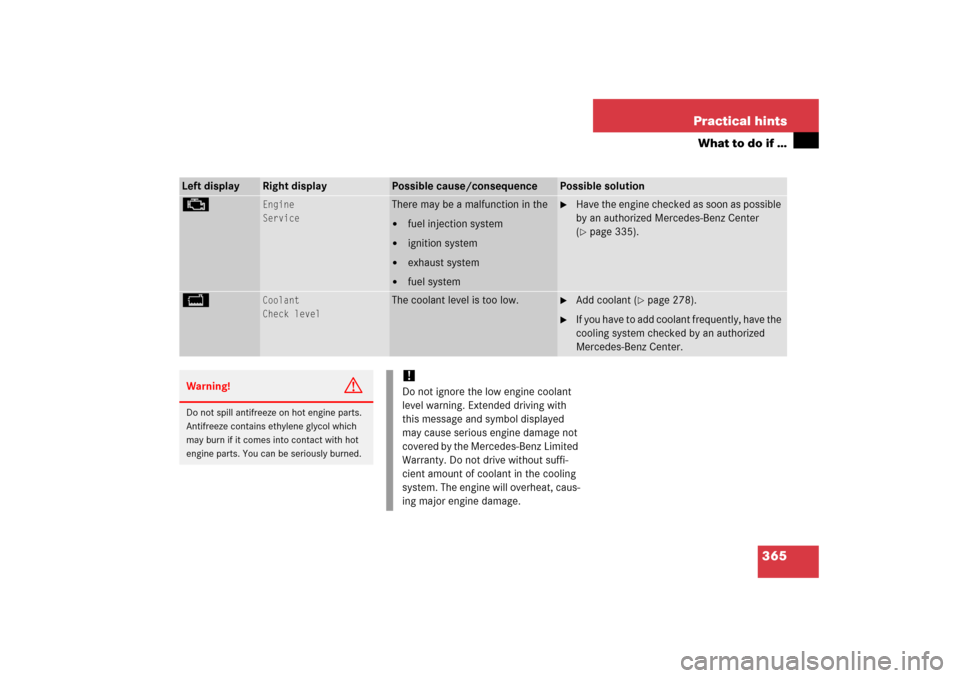
365 Practical hints
What to do if …
Left display
Right display
Possible cause/consequence
Possible solution
±
Engine
Service
There may be a malfunction in the �
fuel injection system
�
ignition system
�
exhaust system
�
fuel system
�
Have the engine checked as soon as possible
by an authorized Mercedes-Benz Center
(�page 335).
B
Coolant
Check level
The coolant level is too low.
�
Add coolant (
�page 278).
�
If you have to add coolant frequently, have the
cooling system checked by an authorized
Mercedes-Benz Center.
Warning!
G
Do not spill antifreeze on hot engine parts.
Antifreeze contains ethylene glycol which
may burn if it comes into contact with hot
engine parts. You can be seriously burned.
!Do not ignore the low engine coolant
level warning. Extended driving with
this message and symbol displayed
may cause serious engine damage not
covered by the Mercedes-Benz Limited
Warranty. Do not drive without suffi-
cient amount of coolant in the cooling
system. The engine will overheat, caus-
ing major engine damage.
Page 370 of 480
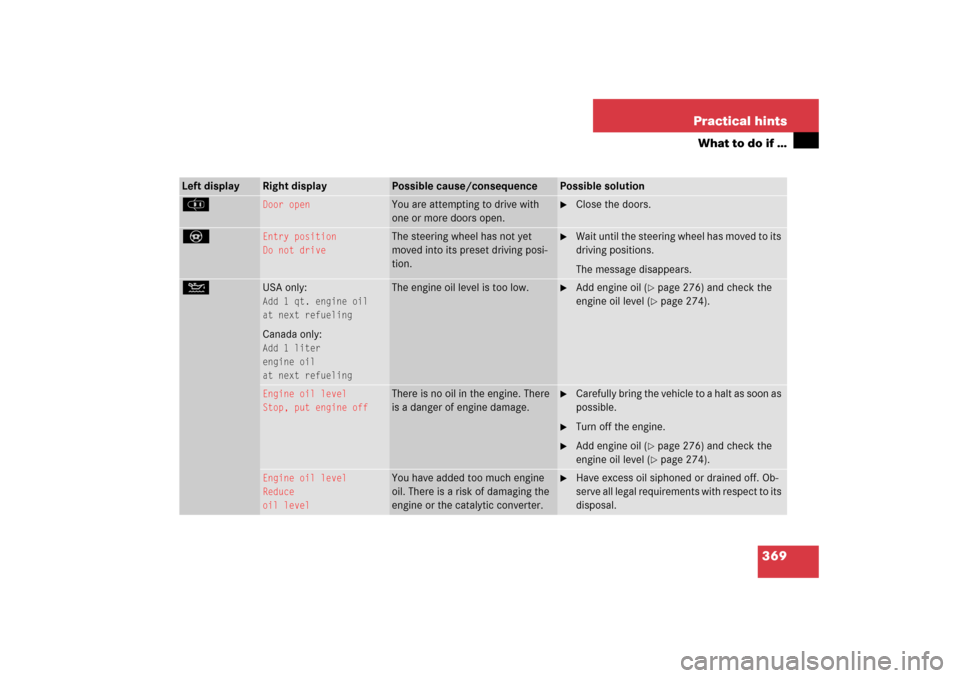
369 Practical hints
What to do if …
Left display
Right display
Possible cause/consequence
Possible solution
J
Door open
You are attempting to drive with
one or more doors open.
�
Close the doors.
_
Entry position
Do not drive
The steering wheel has not yet
moved into its preset driving posi-
tion.
�
Wait until the steering wheel has moved to its
driving positions.
The message disappears.
N
USA only:Add 1 qt. engine oil
at next refuelingCanada only:Add 1 liter
engine oil
at next refueling
The engine oil level is too low.
�
Add engine oil (
�page 276) and check the
engine oil level (�page 274).
Engine oil level
Stop, put engine off
There is no oil in the engine. There
is a danger of engine damage.
�
Carefully bring the vehicle to a halt as soon as
possible.
�
Turn off the engine.
�
Add engine oil (
�page 276) and check the
engine oil level (�page 274).
Engine oil level
Reduce
oil level
You have added too much engine
oil. There is a risk of damaging the
engine or the catalytic converter.
�
Have excess oil siphoned or drained off. Ob-
serve all legal requirements with respect to its
disposal.
Page 371 of 480

370 Practical hintsWhat to do if …When the message
Add 1 qt engine oil
at next refueling (Canada:
1l
) appears
while the engine is running and at
operating temperature, the engine oil level
has dropped to approximately the
minimum level.When this occurs, the warning will first
come on intermittently and then stay on if
the oil level drops further.
If no oil leaks are noted, continue to drive
to the nearest service station where the
engine oil should be topped to the required
level with an approved oil specified in the
Factory Approved Service Products pam-
phlet.
Left display
Right display
Possible cause/consequence
Possible solution
N
Engine oil
Visit workshop!
It may be that there is water in the
engine oil.
�
Have the engine oil checked.
Engine oil level
Visit workshop
The engine oil has dropped to a crit-
ical level.
�
Check the engine oil level (
�page 274) and
add oil as required (
�page 276).
�
If you must add engine oil frequently, have the
engine checked for possible leaks.
The measuring system is malfunc-
tioning.
�
Have the measuring system checked by an
authorized Mercedes-Benz Center.
!The engine oil level warnings should
not be ignored. Extended driving with
the symbol displayed could result in
serious engine damage that is not
covered by the Mercedes-Benz Limited
Warranty.
Page 372 of 480
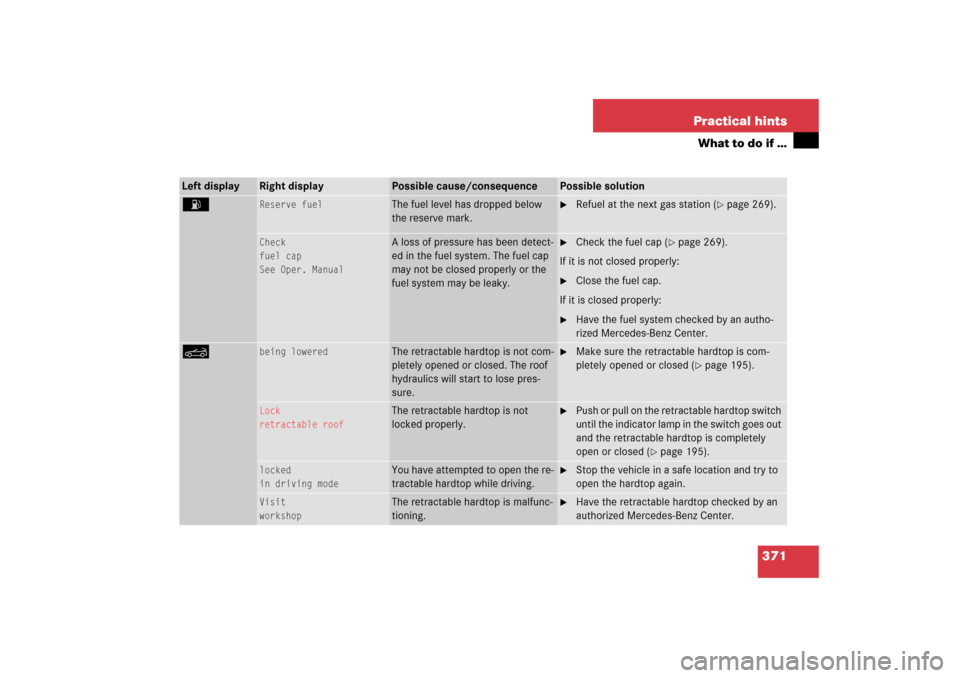
371 Practical hints
What to do if …
Left display
Right display
Possible cause/consequence
Possible solution
A
Reserve fuel
The fuel level has dropped below
the reserve mark.
�
Refuel at the next gas station (
�page 269).
Check
fuel cap
See Oper. Manual
A loss of pressure has been detect-
ed in the fuel system. The fuel cap
may not be closed properly or the
fuel system may be leaky.
�
Check the fuel cap (
�page 269).
If it is not closed properly:
�
Close the fuel cap.
If it is closed properly:
�
Have the fuel system checked by an autho-
rized Mercedes-Benz Center.
K
being lowered
The retractable hardtop is not com-
pletely opened or closed. The roof
hydraulics will start to lose pres-
sure.
�
Make sure the retractable hardtop is com-
pletely opened or closed (
�page 195).
Lock
retractable roof
The retractable hardtop is not
locked properly.
�
Push or pull on the retractable hardtop switch
until the indicator lamp in the switch goes out
and the retractable hardtop is completely
open or closed (
�page 195).
locked
in driving mode
You have attempted to open the re-
tractable hardtop while driving.
�
Stop the vehicle in a safe location and try to
open the hardtop again.
Visit
workshop
The retractable hardtop is malfunc-
tioning.
�
Have the retractable hardtop checked by an
authorized Mercedes-Benz Center.
Page 404 of 480
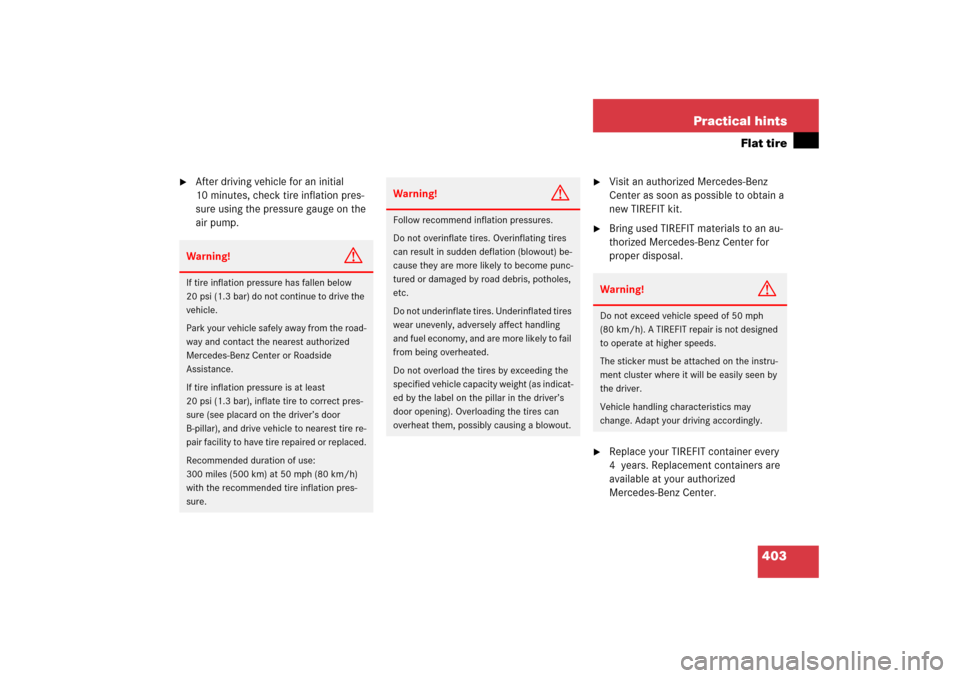
403 Practical hints
Flat tire
�
After driving vehicle for an initial
10 minutes, check tire inflation pres-
sure using the pressure gauge on the
air pump.
�
Visit an authorized Mercedes-Benz
Center as soon as possible to obtain a
new TIREFIT kit.
�
Bring used TIREFIT materials to an au-
thorized Mercedes-Benz Center for
proper disposal.
�
Replace your TIREFIT container every
4 years. Replacement containers are
available at your authorized
Mercedes-Benz Center.
Warning!
G
If tire inflation pressure has fallen below
20 psi (1.3 bar) do not continue to drive the
vehicle.
Park your vehicle safely away from the road-
way and contact the nearest authorized
Mercedes-Benz Center or Roadside
Assistance.
If tire inflation pressure is at least
20 psi (1.3 bar), inflate tire to correct pres-
sure (see placard on the driver’s door
B-pillar), and drive vehicle to nearest tire re-
pair facility to have tire repaired or replaced.
Recommended duration of use:
300 miles (500 km) at 50 mph (80 km/h)
with the recommended tire inflation pres-
sure.
Warning!
G
Follow recommend inflation pressures.
Do not overinflate tires. Overinflating tires
can result in sudden deflation (blowout) be-
cause they are more likely to become punc-
tured or damaged by road debris, potholes,
etc.
Do not underinflate tires. Underinflated tires
wear unevenly, adversely affect handling
and fuel economy, and are more likely to fail
from being overheated.
Do not overload the tires by exceeding the
specified vehicle capacity weight (as indicat-
ed by the label on the pillar in the driver’s
door opening). Overloading the tires can
overheat them, possibly causing a blowout.
Warning!
G
Do not exceed vehicle speed of 50 mph
(80 km/h). A TIREFIT repair is not designed
to operate at higher speeds.
The sticker must be attached on the instru-
ment cluster where it will be easily seen by
the driver.
Vehicle handling characteristics may
change. Adapt your driving accordingly.
Page 411 of 480
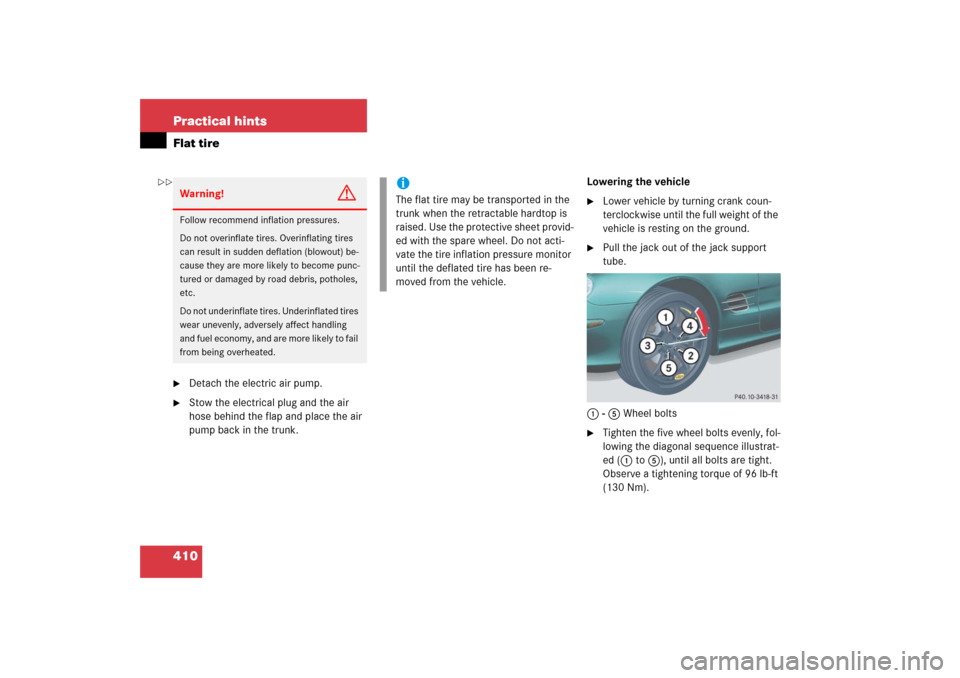
410 Practical hintsFlat tire�
Detach the electric air pump.
�
Stow the electrical plug and the air
hose behind the flap and place the air
pump back in the trunk.Lowering the vehicle
�
Lower vehicle by turning crank coun-
terclockwise until the full weight of the
vehicle is resting on the ground.
�
Pull the jack out of the jack support
tube.
1 - 5 Wheel bolts
�
Tighten the five wheel bolts evenly, fol-
lowing the diagonal sequence illustrat-
ed (1 to 5), until all bolts are tight.
Observe a tightening torque of 96 lb-ft
(130 Nm).
Warning!
G
Follow recommend inflation pressures.
Do not overinflate tires. Overinflating tires
can result in sudden deflation (blowout) be-
cause they are more likely to become punc-
tured or damaged by road debris, potholes,
etc.
Do not underinflate tires. Underinflated tires
wear unevenly, adversely affect handling
and fuel economy, and are more likely to fail
from being overheated.
iThe flat tire may be transported in the
trunk when the retractable hardtop is
raised. Use the protective sheet provid-
ed with the spare wheel. Do not acti-
vate the tire inflation pressure monitor
until the deflated tire has been re-
moved from the vehicle.
��
Page 420 of 480
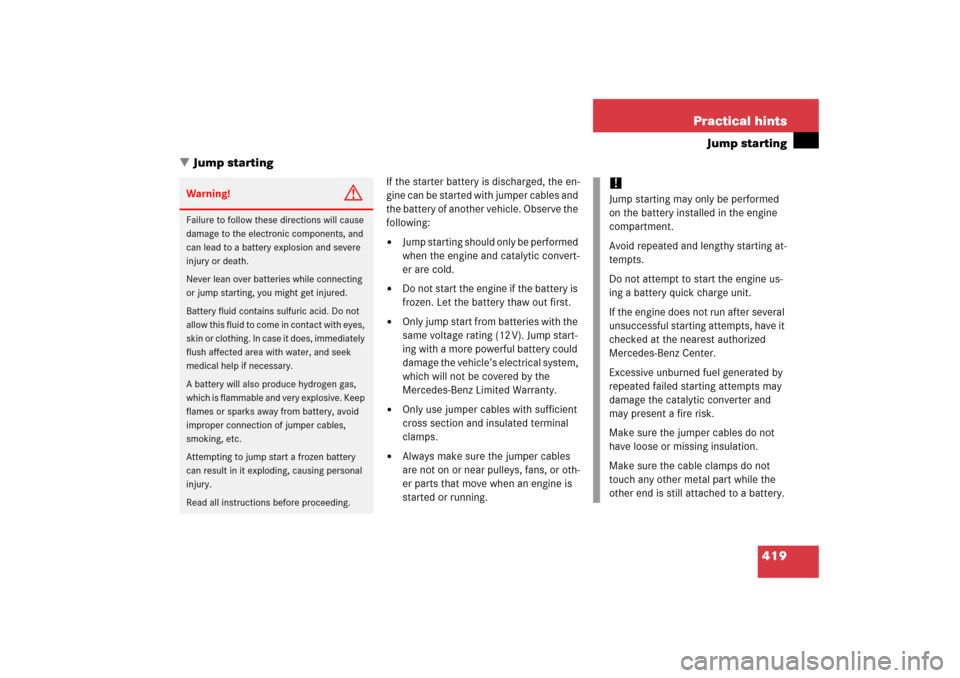
419 Practical hints
Jump starting
�Jump starting
If the starter battery is discharged, the en-
gine can be started with jumper cables and
the battery of another vehicle. Observe the
following:�
Jump starting should only be performed
when the engine and catalytic convert-
er are cold.
�
Do not start the engine if the battery is
frozen. Let the battery thaw out first.
�
Only jump start from batteries with the
same voltage rating (12 V). Jump start-
ing with a more powerful battery could
damage the vehicle’s electrical system,
which will not be covered by the
Mercedes-Benz Limited Warranty.
�
Only use jumper cables with sufficient
cross section and insulated terminal
clamps.
�
Always make sure the jumper cables
are not on or near pulleys, fans, or oth-
er parts that move when an engine is
started or running.
Warning!
G
Failure to follow these directions will cause
damage to the electronic components, and
can lead to a battery explosion and severe
injury or death.
Never lean over batteries while connecting
or jump starting, you might get injured.
Battery fluid contains sulfuric acid. Do not
allow this fluid to come in contact with eyes,
skin or clothing. In case it does, immediately
flush affected area with water, and seek
medical help if necessary.
A battery will also produce hydrogen gas,
which is flammable and very explosive. Keep
flames or sparks away from battery, avoid
improper connection of jumper cables,
smoking, etc.
Attempting to jump start a frozen battery
can result in it exploding, causing personal
injury.
Read all instructions before proceeding.
!Jump starting may only be performed
on the battery installed in the engine
compartment.
Avoid repeated and lengthy starting at-
tempts.
Do not attempt to start the engine us-
ing a battery quick charge unit.
If the engine does not run after several
unsuccessful starting attempts, have it
checked at the nearest authorized
Mercedes-Benz Center.
Excessive unburned fuel generated by
repeated failed starting attempts may
damage the catalytic converter and
may present a fire risk.
Make sure the jumper cables do not
have loose or missing insulation.
Make sure the cable clamps do not
touch any other metal part while the
other end is still attached to a battery.
Page 428 of 480
427 Technical data
Parts service
Warranty coverage
Identification labels
Layout of poly-V-belt drive
Engine
Rims and tires
Electrical system
Main dimensions
Weights
Fuels, coolants, lubricants, etc.